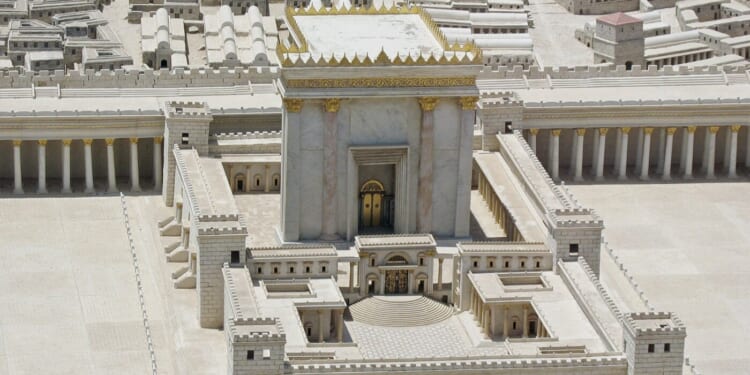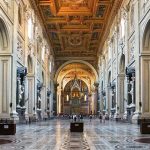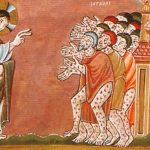Since the Passover was near Jesus went up to Jerusalem.
That sounds odd because Jerusalem was in the south of Israel. That’s like being from New York and saying, “We’re going to go up to Florida for vacation.”
But Christ went up to Jerusalem because the city sits on top of a mountain. It’s 2,600 feet above sea level. The Sea of Galilee, 70 miles to the north, where Christ lived, is 700 feet below sea level. So, if pilgrims like Christ were going to go to Jerusalem for the feasts, as the law commanded, they were going up. Psalm 122 says: “I rejoiced because they said to me, “We will go up to the house of the LORD.”
As pilgrims approached Jerusalem, they would spot the temple, which sat way up high on the temple mount. Its polished marble gleamed in the sun, as well as the gold spikes on the roofs which kept the birds off. Zeal consumed the pilgrims as they made their approach nearer and nearer, for the temple was not only breathtakingly beautiful and massive, but it was also the dwelling of the Lord, the holiest place on earth.
So, picture yourself as a pilgrim, climbing in anxious anticipation up to the Holy City. You finally enter the gate to the temple area…and it has been turned into a market. A line between the sacred and profane has been crossed. What do you do if you are a faithful Jew, zealous for your Father’s house, and you come across this defilement? Christ made a whip out of cords and drove it out.
Do you think Christ offended people by doing that? “Offended” is putting it lightly. He had just disrupted a huge day of commerce conducted by the “den of thieves” who ran the temple (Mt. 21:13). This passage is even more evidence refuting the idea that Christ was harmless, gentle, and “nice,” instead of the threatening and imposing person He truly was.
Speaking of imposing, if you search “Lateran Basilica Virtual Tour” (here’s a good one!), you can walk through a church dedicated on November 9, 324 AD. And like all those pilgrims at the time of Christ, your jaw will drop at the magnificence and splendor inside the mother church of all Christendom.
To regard Christ as imposing and threatening surely sounds odd to our modern ears, but think about it: Anyone else that dared to do what Christ did in the temple would surely have been beaten on the spot, if not killed. In this case, the stunned den of thieves could only ask Christ for a sign for His actions. He could have responded by saying that He was God and that the sacrificing of animals was no longer needed. But instead, He responded with a strange remark about destroying temples. His cryptic answer only made sense three days after His death, when the disciples came to believe the Scriptures.
What do the Scriptures tell us? A little less than 600 years before Christ was born, Ezekiel, a Jewish exile living in Babylon, had a vision:
…and I saw water flowing out from beneath the threshold of the temple toward the east, for the façade of the temple was toward the east; the water flowed down from the southern side of the temple, south of the altar.
It flowed down to the south, down to the desert, to the Dead Sea, which is 1,400 feet below sea level—the lowest spot on earth. The Dead Sea is dead because it is full of salt; nothing can live in it. But the angel told Ezekiel that the water flowing from the temple would give life to all creatures. The sea of salt would be made fresh, “for they shall be watered by the flow from the sanctuary.” On the banks of this stream, this river, fruit trees shall grow; “their leaves shall not fade, nor their fruit fail.” The fruit will be our food, the leaves our medicine.
The Passover of the Jews was near.
At the time of Christ, there could have been over a million, perhaps even two million Jews in Jerusalem for the feast. The Jewish historian Josephus, a priest who was present when the Jerusalem temple was destroyed in 70 AD, wrote that over 250,000 Passover lambs were slaughtered and sacrificed during a typical Passover. Can you imagine? The temple was turned into an utter slaughterhouse. It begs the question: What did they do with all the blood?
Recall what the Apostle John wrote about what he saw on Calvary. He wrote that when the dead Christ’s side was pierced, water and blood poured out. Then John emphasized that he was really there—that he saw it in person: “He who saw it has borne witness—his testimony is true, and he knows that he tells the truth—that you also may believe” (Jn. 19:35).
What would Jewish pilgrims have seen pouring out of the temple at Passover? Rabbis state that there was a drainage system under the temple’s altar. The temple faced east, and directly to the east of the temple was the steep Kidron Valley. The priests drained the blood and flushed it out with water.
So, pilgrims would have seen a stream of blood and water flowing from the side of the temple. It flowed down into the Brook Kidron and eventually made its way south into the Arabah and the Dead Sea. The Apostle John saw blood and water flowing from the side of the true temple on Calvary.
Since Passover was near Jesus went up to Jerusalem.
Jesus went up to offer the one, true, and everlasting sacrifice on the altar of the Cross. Since Christ called Himself the temple, traditionally our churches were constructed with the Jerusalem temple in mind. They featured priests, standing in for Christ, offering His one, true sacrifice in an elevated sanctuary.
That reality has been turned on its head in our day. In most places, modern church buildings do not have us climbing in anxious anticipation up to the Lord. Instead, He has been dragged down to our level by the flattening of our church structures. Some have even gone beyond the flattening out and are built more like theaters or entertainment venues than temples of sacrifice. In a total reversal of liturgical theology, some sanctuaries have become the lowest part of the building.
Now ask yourself: How can water flow from the sanctuary when the sanctuary is in the lowest spot of the building? Isn’t that like turning the building into the “Church of the Dead Sea” where nothing can live?
I rejoiced because they said to me, “We will go up to the house of the LORD.” (Ps. 122:1)
Let us rejoice and go up to the house of the LORD and be watered by the flow from the sanctuary. This is my blood poured out for you, Christ says, our magnificent and imposing temple, as He prepares the divine slaughter that brings a dead world back to life.
Along both banks of the river, fruit trees of every kind shall grow.
These are altars where today and every day the river of life flowing from the side of our temple washes down on our sinful world. This is the Holy Sacrifice of Mass, where the fruit of the tree will be our food, and the leaves our medicine.
Image from Wikimedia Commons













